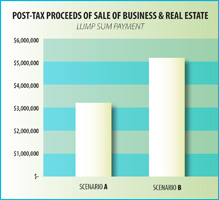
I am looking to sell my business, or I have been approached by a competitor or investor to acquire my business. Regardless of the angle, the ultimate discussion topic comes down to: How much is enough? For family business owners, surveys suggest well over 90 percent of their primary income is derived from their business, so making sure the proceeds of the sale is a sufficient nest egg is critical.
Where do you begin? Often times it is difficult to forecast future cash flow needs, so it is typically easier to use the current cash flow received by the business owner as a baseline. Then, an adjustment is made to that figure as you attempt to differentiate between consumption and savings. (How much of the cash flow is truly being consumed, and how much is being saved or passed down to the next generation?)
Sources of cash flow will include not only W-2 wages, but also earnings distributions from your S-Corp or LLC. In addition, if real estate is part of the sale scenario, you need to include the rental income from that asset as well. Expenses reimbursed by the company are also part of this calculation, so ownership prerogative expenses such as a company car, travel, meals and entertainment should be included, in addition to traditional items such as health and life insurance.
In addition to the company as an asset, in many instances, company owners have also funded and maintained a qualified retirement plan and salted away additional monies in taxable investment accounts. The combination of the post-tax proceeds received in the company sale and these other investment assets will comprise the investment portfolio used to provide the replacement income. At break-even, this portfolio will provide approximately the same rate of inflation adjusted post-tax cash flow as one earned while both actively employed and as a business owner.
------------------------------------------------------
A STRAIGHTFORWARD WORKING EXAMPLE
The ACME Widget Company
John Smith, president, age 65
ASSETS
100% Shareholder, ACME (S-Corp): ----------
401(k)/Profit Sharing Retirement Plan: $600,000
Taxable Revocable Trust: $400,000
Total: $1,000,000
SOURCES OF CASH FLOW
W-2 Wage & Bonus: $250,000
Annual S-Corp Distribution: $150,000
Real Estate Rental Income: $36,000
Total: $436,000
Company Reimbursed Expenses: $12,000
OTHER INPUTS
Life Expectancy: 20 Years
Inflation Rate (used to adjust future cash flows): 2.5%
Current Tax Rate (predominately ordinary income): 40%
Post-Transaction Tax Rate (Ordinary/cap gains/qualified dividend): 25%
Consumption Factor: 80%
Investment Rate of Return: 6%
-----------------------------------------------------
Targeted Future Value
The last input that needs to be discussed is the future value of the investment portfolio at the end of the term.
Scenario A. Some business owners express the view that at the end of the period, they hope they have consumed every last cent. In that instance, the annuity stream for 20 years takes into consideration not only the investment earnings, but the return of principal back to the owner.
Scenario B. Others have a desire to pass onto the next generation at least as much as they had accumulated upon the sale of the company and subsequent retirement. Under those circumstances, the beginning portfolio value has to be large enough that the earnings rate is sufficient to cover the inflation adjusted cash flow withdrawn from the portfolio.
 As you can see, there is a significant difference in the required lump sum proceeds of the sale, depending upon one’s end goal.
As you can see, there is a significant difference in the required lump sum proceeds of the sale, depending upon one’s end goal.
This working example is simply intended to provide a basic illustration as to the financial approach one needs to pursue when contemplating the sale of a privately held business. It does not address the myriad of other issues that also need to be considered as business owners attempt to put their arms around this complex subject.
Beyond the financial calculations, trust and estate planning, tax analysis, investment risk and return profile, and charitable intent are all topics for thoughtful discussion and deliberation. There are few greater emotional decisions than the sale of a family-owned business. Aligning yourself with experienced tax, legal and financial advisors who are familiar with the traps and pitfalls of the process will be most beneficial as one weighs the pros and cons of a transaction. iBi
Lawrence “ Will’” Williams IV is president of David Vaughan Investments, Inc. (DVI).

